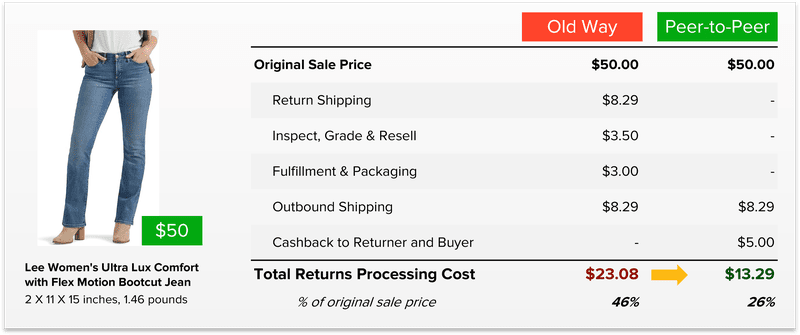Top 7 Ecommerce Return Strategies and Overcoming Reverse Logistics Challenges

Last updated on March 26, 2025

In this article
 8 minutes
8 minutes
- What Are Ecommerce Returns and Return Policy?
- The Impact of Ecommerce Returns on Customer Satisfaction and Repeat Business
- Challenges in Ecommerce Returns and Customer Satisfaction
- Creating an Effective Ecommerce Return Policy
- Strategies for Reducing Ecommerce Return Rates
- The Cost of Ecommerce Returns
- Mitigating Return Fraud in Ecommerce
- Top 7 Reverse Logistics Strategies for Ecommerce
- Conclusion
- Frequently Asked Questions
Returns are an inevitable part of ecommerce. The average ecommerce return rate varies across different product categories, with some sectors like fashion experiencing return rates as high as 30%. While they offer customers the flexibility to shop with confidence, they also present significant challenges for retailers. Let’s delve into what ecommerce returns entail, the hurdles they introduce, and effective strategies to manage them.
What Are Ecommerce Returns and Return Policy?
Ecommerce returns, also known as customer returns, refer to the process where customers send back products they’ve purchased online to the retailer or manufacturer. This can occur for various reasons, such as receiving defective items, incorrect sizes, or simply a change of mind. The process of handling these returns, known as reverse logistics, involves the movement of goods from the customer back to the Seller, encompassing activities like transportation, inspection, refurbishment, and restocking.
The Impact of Ecommerce Returns on Customer Satisfaction and Repeat Business
Ecommerce returns can significantly influence customer satisfaction. When online shoppers find it easy to return products that do not meet their expectations, their overall shopping experience improves. As many as 84% of online shoppers review a retailer’s return policy before making a purchase. A clear and generous return policy not only enhances customer satisfaction but also fosters customer loyalty and encourages repeat business. Conversely, a complicated or restrictive return policy can lead to frustration and a loss of trust in the retailer. Therefore, ecommerce businesses must prioritize creating a customer-friendly returns process to maintain a positive customer experience.
Challenges in Ecommerce Returns and Customer Satisfaction
Managing ecommerce returns is fraught with challenges that can impact a retailer’s profitability and customer satisfaction:
- High Return Rates: Online purchases, especially in categories like fashion, often see return rates as high as 30%, significantly higher than brick-and-mortar stores. This surge is partly fueled by practices like ‘wardrobing‘ and ‘bracketing‘, where customers buy multiple sizes or styles with the intention of returning unwanted items.
- Operational Costs: Processing returns involves costs related to shipping orders back to Sellers, inspection, repackaging, restocking, and reselling, reshipping to new customers. These expenses quickly erode most profit margins, making efficient reverse logistics crucial.
- Inventory Management: Returned products re-entering the supply chain can disrupt inventory levels, leading to challenges in demand forecasting and storage.
- Environmental Impact: The logistics of returns contribute to higher carbon emissions, and improperly managed returns can result in waste, raising sustainability concerns.
Creating an Effective Ecommerce Return Policy
Crafting an effective ecommerce return policy requires careful consideration of several key factors. First and foremost, the policy should be clear and easy to understand, with prominent links available on the website and mobile app (if applicable). It should outline the conditions, procedures, and timeframes for returns, as well as any associated costs or fees. Flexibility is also key; allowing customers to easily initiate returns and exchanges can significantly enhance their experience which promotes trust in the brand and increases the likelihood of reengagement in the future. Additionally, communicating the return policy clearly at the time of purchase helps set customer expectations and avoid misunderstandings. By focusing on these elements, ecommerce businesses can create a return policy that supports customer satisfaction and loyalty.
Strategies for Reducing Ecommerce Return Rates
Ecommerce businesses can employ several strategies to reduce return rates effectively. One of the most impactful approaches is to provide detailed and accurate product descriptions, including high-quality images and videos. This helps customers make informed purchasing decisions, reducing the likelihood of returns due to product mismatch. Offering free return shipping can also encourage customers to make purchases with confidence, knowing they can return items without additional costs. Additionally, leveraging data analytics to identify patterns and trends in returns allows businesses to make targeted improvements to their products and services. By implementing these strategies, ecommerce businesses can minimize return rates and enhance customer satisfaction.
The Cost of Ecommerce Returns
Ecommerce returns can be a significant financial burden for online retailers, with the average cost of processing a return estimated to be around 20-30% of the item’s original value. These costs include shipping, restocking, and customer service expenses. Returns can also disrupt inventory management, as returned products may need to be restocked or resold. To mitigate these costs, ecommerce businesses can offer store credit or exchanges instead of refunds, encouraging customers to make additional purchases. Utilizing data analytics to identify and address the root causes of returns can also help reduce return rates and associated costs. By adopting these strategies, online retailers can better manage the financial impact of ecommerce returns.
Mitigating Return Fraud in Ecommerce
Return fraud poses a significant challenge for ecommerce businesses, with estimates suggesting that up to 10% of returns are fraudulent. To combat this issue, ecommerce businesses can implement several strategies. Utilizing data analytics to identify patterns and trends in returns can help flag suspicious activity. Requiring customers to provide proof of purchase or identification when initiating a return adds an extra layer of security. Additionally, employing technology such as RFID tags or serial numbers to track products and verify their authenticity can further reduce the risk of return fraud. By taking these steps, ecommerce businesses can protect their bottom line and ensure a more secure returns process.
Top 7 Reverse Logistics Strategies for Ecommerce
To navigate these challenges, retailers can implement the following strategies:
- Develop a Customer-Centric Returns Policy
- Description: Craft a clear, transparent, and flexible returns policy that outlines the conditions and process for returns.
- Importance: A customer-friendly policy engenders trust and encourages repeat business. When customers know they can return products hassle-free, they’re more likely to make a purchase.
- Risks of Neglect: A confusing or rigid returns policy can deter potential buyers and harm the brand’s reputation.
- Leverage Technology for Returns Management
- Description: Utilize software solutions to automate and track the returns process, providing real-time data and analytics. Keeping customers informed about their return’s status throughout the process can enhance customer satisfaction and loyalty.
- Importance: Technology streamlines operations, reduces errors, and offers insights into return patterns, helping to identify and address root causes.
- Risks of Neglect: Without automation, the returns process can become inefficient, leading to delays and increased operational costs.
- Implement Quality Control Measures
- Description: Conduct thorough inspections before shipping to ensure products meet quality standards, reducing the likelihood of returns due to defects.
- Importance: High-quality products lead to higher customer satisfaction and fewer returns.
- Risks of Neglect: Poor quality control can result in a higher volume of returns, increased costs, and damage to brand reputation.
- Offer Accurate Product Descriptions and Images
- Description: Provide detailed and accurate product information, including high-quality images, to set correct customer expectations.
- Importance: Clear product representation helps customers make informed decisions, reducing returns due to unmet expectations.
- Risks of Neglect: Misleading or inadequate product information can lead to dissatisfaction and increased return rates.
- Analyze Return Data
- Description: Regularly review return data to identify trends and common reasons for returns.
- Importance: Understanding why products are returned enables retailers to make necessary adjustments, whether in product design, description, or quality.
- Risks of Neglect: Ignoring return data prevents the identification of systemic issues, leading to recurring problems and customer dissatisfaction.
- Optimize Packaging
- Description: Use packaging that protects products during transit and is easy for customers to reuse if they need to make a return.
- Importance: Proper packaging minimizes damage during shipping and simplifies the returns process for customers.
- Risks of Neglect: Inadequate packaging can lead to product damage, increased returns, and higher costs.
- Educate Customers
- Description: Provide guidance on product usage, sizing charts, and care instructions to help customers make informed purchases.
- Importance: Educated customers are less likely to make returns due to misunderstandings or incorrect usage.
- Risks of Neglect: Lack of customer education can lead to misuse, dissatisfaction, and increased return rates.
Conclusion
Online shopping returns are a complex but manageable aspect of online retail. By implementing customer-centric policies, leveraging technology, ensuring product quality, providing accurate information, analyzing return data, optimizing packaging, and educating customers, retailers can effectively navigate the challenges of reverse logistics. These strategies not only reduce operational costs but also increase the likelihood of establishing a customer relationship and loyalty, leading to long-term success.
Frequently Asked Questions
Why are ecommerce return rates so high?
Ecommerce return rates are higher than in-store purchases because customers can’t physically inspect items before buying. Factors like incorrect sizing, unmet expectations, and bracketing (ordering multiple sizes or styles) contribute to high return rates.
How can businesses reduce return rates?
Businesses can minimize returns by offering accurate product descriptions, high-quality images, and clear sizing guides. Investing in quality control, analyzing return data, and providing excellent customer education also play key roles.
What are the biggest challenges in managing ecommerce returns?
The main challenges include high processing costs, inventory disruptions, potential fraud, and environmental impact. A well-structured reverse logistics strategy helps mitigate these issues.
How can retailers prevent return fraud?
Retailers can combat return fraud by using data analytics to detect suspicious activity, requiring proof of purchase, tracking serial numbers, and implementing stricter return policies for high-risk items.
What role does packaging play in reducing returns?
Secure, well-designed packaging prevents damage during transit and makes it easier for customers to return items if necessary. Sustainable, reusable packaging also improves cost efficiency and reduces waste.

Up to 64% Lower Returns Processing Cost


